Dance
| Dance | |
|---|---|
 | |
| Originating culture | Various |
| Originating era | Prehistory-Antiquity |
Dance is a performance art form consisting of purposefully selected sequences of human movement. This movement has aesthetic and symbolic value, and is acknowledged as dance by performers and observers within a particular culture.[nb 1] Dance can be categorized and described by its choreography, by its repertoire of movements, or by its historical period or place of origin.
An important distinction is to be drawn between the contexts of theatrical and participatory dance,[4] although these two categories are not always completely separate; both may have special functions, whether social, ceremonial, competitive, erotic, martial, or sacred/liturgical. Other forms of human movement are sometimes said to have a dance-like quality, including martial arts, gymnastics, figure skating, synchronized swimming and many other forms of athletics.
Performance and participation
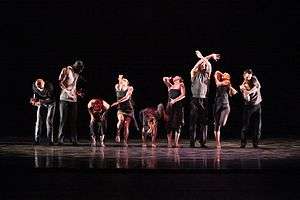
Theatrical dance, also called performance or concert dance, is intended primarily as a spectacle, usually a performance upon a stage by virtuoso dancers. It often tells a story, perhaps using mime, costume and scenery, or else it may simply interpret the musical accompaniment, which is often specially composed. Examples are western ballet and modern dance, Classical Indian dance and Chinese and Japanese song and dance dramas. Most classical forms are centred upon dance alone, but performance dance may also appear in opera and other forms of musical theatre.
Participatory dance, on the other hand, whether it be a folk dance, a social dance, a group dance such as a line, circle, chain or square dance, or a partner dance such as is common in western Western ballroom dancing, is undertaken primarily for a common purpose, such as social interaction or exercise, of participants rather than onlookers. Such dance seldom has any narrative. A group dance and a corps de ballet, a social partner dance and a pas de deux, differ profoundly. Even a solo dance may be undertaken solely for the satisfaction of the dancer. Participatory dancers often all employ the same movements and steps but, for example, in the rave culture of electronic dance music, vast crowds may engage in free dance, uncoordinated with those around them. On the other hand, some cultures lay down strict rules as to the particular dances in which, for example, men, women and children may or must participate.
Origins

Archeological evidence for early dance includes 9,000-year-old paintings in India at the Rock Shelters of Bhimbetka, and Egyptian tomb paintings depicting dancing figures, dated c. 3300 BC. It has been proposed that before the invention of written languages, dance was an important part of the oral and performance methods of passing stories down from generation to generation.[5] The use of dance in ecstatic trance states and healing rituals (as observed today in many contemporary "primitive" cultures, from the Brazilian rainforest to the Kalahari Desert) is thought to have been another early factor in the social development of dance.[6]
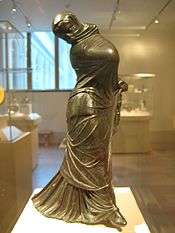
References to dance can be found in very early recorded history; Greek dance (horos) is referred to by Plato, Aristotle, Plutarch and Lucian.[7] The Bible and Talmud refer to many events related to dance, and contain over 30 different dance terms.[8] In Chinese pottery as early as the Neolithic period, groups of people are depicted dancing in a line holding hands,[9] and the earliest Chinese word for "dance" is found written in the oracle bones.[10] Dance is further described in the Lüshi Chunqiu.[11][12] Primitive dance in ancient China was associated with sorcery and shamanic rituals.
During the first millennium BCE in India, many texts were composed which attempted to codify aspects of daily life. Bharata Muni's Natyashastra (literally "the text of dramaturgy") is one of the earlier texts. It mainly deals with drama, in which dance plays an important part in Indian culture. It categorizes dance into four types - secular, ritual, abstract, and, interpretive - and into four regional varieties. The text elaborates various hand-gestures (mudras) and classifies movements of the various limbs, steps and so on. A strong continuous tradition of dance has since continued in India, through to modern times, where it continues to play a role in culture, ritual, and, notably, the Bollywood entertainment industry. Many other contemporary dance forms can likewise be traced back to historical, traditional, ceremonial, and ethnic dance.
Dance and music
Dance is generally, though not exclusively, performed with the accompaniment of music and may or may not be performed in time to such music. Some dance (such as tap dance) may provide its own audible accompaniment in place of (or in addition to) music. Many early forms of music and dance were created for each other and are frequently performed together. Notable examples of traditional dance/music couplings include the jig, waltz, tango, disco, and salsa. Some musical genres have a parallel dance form such as baroque music and baroque dance; other varieties of dance and music may share nomenclature but developed separately, such as classical music and classical ballet.
Dance and rhythm
Rhythm and dance are deeply linked in history and practice. The American dancer Ted Shawn wrote; "The conception of rhythm which underlies all studies of the dance is something about which we could talk forever, and still not finish."[13] A musical rhythm requires two main elements; first, a regularly-repeating pulse (also called the "beat" or "tactus") that establishes the tempo and, second, a pattern of accents and rests that establishes the character of the metre or basic rhythmic pattern. The basic pulse is roughly equal in duration to a simple step or gesture.
Dances generally have a characteristic tempo and rhythmic pattern. The tango, for example, is usually danced in 2
4 time at approximately 66 beats per minute. The basic slow step, called a "slow", lasts for one beat, so that a full "right–left" step is equal to one 2
4 measure. The basic forward and backward walk of the dance is so counted - "slow-slow" - while many additional figures are counted "slow - quick-quick.[14]
Just as musical rhythms are defined by a pattern of strong and weak beats, so repetitive body movements often depends on alternating "strong" and "weak" muscular movements.[15] Given this alternation of left-right, of forward-backward and rise-fall, along with the bilateral symmetry of the human body, it is natural that many dances and much music are in duple and quadruple meter. However, since some such movements require more time in one phase than the other - such as the longer time required to lift a hammer than to strike - some dance rhythms fall equally naturally into triple metre.[16] Occasionally, as in the folk dances of the Balkans, dance traditions depend heavily on more complex rhythms. Further, complex dances composed of a fixed sequence of steps always require phrases and melodies of a certain fixed length to accompany that sequence.
.jpg)
The very act of dancing, the steps themselves, generate an "initial skeleton of rhythmic beats" that must have preceded any separate musical accompaniment, while dance itself, as much as music, requires time-keeping[17] just as utilitarian repetitive movements such as walking, hauling and digging take on, as they become refined, something of the quality of dance.[15]
Musical accompaniment therefore arose in the earliest dance, so that ancient Egyptians attributed the origin of the dance to the divine Athotus, who was said to have observed that music accompanying religious rituals caused participants to move rhythmically and to have brought these movements into proportional measure. The same idea, that dance arises from musical rhythm, is still found in renaissance Europe in the works of the dancing master Guglielmo Ebreo da Pesaro who speaks of dance as a physical movement that arises from and expresses inward, spiritual motion agreeing with the "measures and perfect concords of harmony" that fall upon the human ear,[15] while, earlier, Mechthild of Magdeburg, seizing upon dance as a symbol of the holy life foreshadowed in Jesus' saying "I have piped and ye have not danced",[18] writes;
I can not dance unless thou leadest. If thou wouldst have me spring aloft, sing thou and I will spring, into love and from love to knowledge and from knowledge to ecstasy above all human sense[19]
Thoinot Arbeau's celebrated 16th century dance-treatise Orchésographie, indeed, begins with definitions of over eighty distinct drum-rhythms.[20]
.jpg)
As has been shown above, dance has been represented through the ages as having emerged as a response to music yet, as Lincoln Kirstein implied, it is at least as likely that primitive music arose from dance. Shawn concurs, stating that dance "was the first art of the human race, and the matrix out of which all other arts grew" and that even the "metre in our poetry today is a result of the accents necessitated by body movement, as the dancing and reciting were performed simultaneously"[13] - an assertion somewhat supported by the common use of the term "foot" to describe the fundamental rhythmic units of poetry.
Scholes, not a dancer but a musician, offers support for this view, stating that the steady measures of music, of two, three or four beats to the bar, its equal and balanced phrases, regular cadences, contrasts and repetitions, may all be attributed to the "incalculable" influence of dance upon music.[21]
Émile Jaques-Dalcroze, primarily a musician and teacher, relates how a study of the physical movements of pianists led him "to the discovery that musical sensations of a rhythmic nature call for the muscular and nervous response of the whole organism", to develop "a special training designed to regulate nervous reactions and effect a co-ordination of muscles and nerves" and ultimately to seek the connections between "the art of music and the art of dance", which he formulated into his system of eurhythmics.[22] He concluded that "musical rhythm is only the transposition into sound of movements and dynamisms spontaneously and involuntarily expressing emotion".[23]
Hence, though doubtless, as Shawn asserts, "it is quite possible to develop the dance without music and... music is perfectly capable of standing on its own feet without any assistance from the dance", nevertheless the "two arts will always be related and the relationship can be profitable both to the dance and to music",[24] the precedence of one art over the other being a moot point. The common ballad measures of hymns and folk-songs takes their name from dance, as does the carol, originally a circle dance. Many purely musical pieces have been named "waltz" or "minuet", for example, while many concert dances have been produced that are based upon abstract musical pieces, such as 2 and 3 Part Inventions, Adams Violin Concerto and Andantino. Similarly, poems are often structured and named after dances or musical works, while dance and music have both drawn their conception of "measure" or "metre" from poetry.
Shawn quotes with approval the statement of Dalcroze that, while the art of musical rhythm consists in differentiating and combining time durations, pauses and accents "according to physiological law", that of "plastic rhythm" (i.e. dance) "is to designate movement in space, to interpret long time-values by slow movements and short ones by quick movements, regulate pauses by their divers successions and express sound accentuations in their multiple nuances by additions of bodily weight, by means of muscular innervations".
Shawn nevertheless points out that the system of musical time is a "man-made, artificial thing.... a manufactured tool, whereas rhythm is something that has always existed and depends on man not at all", being "the continuous flowing time which our human minds cut up into convenient units", suggesting that music might be revivified by a return to the values and the time-perception of dancing.[25]
The early-20th-century American dancer Helen Moller stated simply that "it is rhythm and form more than harmony and color which, from the beginning, has bound music, poetry and dancing together in a union that is indissoluble."[26]
Approaches to dance
Concert dance
Concert dance, like opera, generally depends for its large-scale form upon a narrative dramatic structure. The movements and gestures of the choreography are primarily intended to mime the personality and aims of the characters and their part in the plot.[27] Such theatrical requirements tend towards longer, freer movements than those usual in non-narrative dance styles. On the other hand the ballet blanc, developed in the 19th century, allows interludes of rhythmic dance that developed into entirely "plotless" ballets in the 20th century.[28] and that allowed fast, rhythmic dance-steps such as those of the petit allegro. A well-known example is The Cygnets' Dance in act two of Swan Lake.
The ballet developed out of courtly dramatic productions of 16th- and 17th-century France and Italy and for some time dancers performed dances developed from those familiar from the musical suite,[29] all of which were defined by definite rhythms closely identified with each dance. These appeared as character dances in the era of romantic nationalism.
Ballet reached widespread vogue in the romantic era, accompanied by a larger orchestra and grander musical conceptions that did not lend themselves easily to rhythmic clarity and by dance that emphasised dramatic mime. A broader concept of rhythm was needed, that which Rudolf Laban terms the "rhythm and shape" of movement that communicates character, emotion and intention,[30] while only certain scenes required the exact synchronisation of step and music essential to other dance styles, so that, to Laban, modern Europeans seemed totally unable to grasp the meaning of "primitive rhythmic movements",[31] a situation that began to change in the 20th century with such productions as Igor Stravinsky's The Rite of Spring with its new rhythmic language evoking primal feelings of a primitive past.[32]
Indian classical dance styles, like ballet, are often in dramatic form, so that there is a similar complementarity between narrative expression and "pure" dance. In this case, however, the two are separately defined, though not always separately performed. The rhythmic elements, which are abstract and technical, are known as nritta. Both this and expressive dance (nritya), though, are closely tied to the rhythmic system (tala). Teachers have adapted the spoken rhythmic mnemonic system called bol to the needs of dancers.
Japanese classical dance-theatre styles such as Kabuki and Noh, like Indian dance-drama, distinguish between narrative and abstract dance productions. The three main categories of kabuki are jidai-mono (historical), sewa-mono (domestic) and shosagoto (dance pieces).[33] Somewhat similarly, Noh distinguishes between Geki Noh, based around the advancement of plot and the narration of action, and Furyū Noh, dance pieces involving acrobatics, stage properties, multiple characters and elaborate stage action.[34]
Participatory and social dance
Dances intended for participation rather than for an audience may include various forms of mime and narrative but are typically set much more closely to the rhythmic pattern of music, so that terms like waltz and polka refer as much to musical pieces as to the dance itself. The rhythm of the dancers' feet may even form an essential part of the music as in tap dance. African dance, for example, is rooted in fixed basic steps but may also allow a high degree of rhythmic interpretation, the feet or the trunk marking the basic pulse while cross-rhythms are picked up by shoulders, knees or head, the best dancers simultaneously giving plastic expression to all the elements of the polyrhythmic pattern.[35]
Cultural traditions
Africa
.jpg)
Dance in Africa is deeply integrated into society and major events in a community are frequently reflected in dances: dances are performed for births and funerals, weddings and wars.[36]:13 Traditional dances impart cultural morals, including religious traditions and sexual standards; give vent to repressed emotions, such as grief; motivate community members to cooperate, whether fighting wars or grinding grain; enact spiritual rituals; and contribute to social cohesiveness.[37]
Thousands of dances are performed around the continent. These may be divided into traditional, neotraditional, and classical styles: folkloric dances of a particular society, dances created more recently in imitation of traditional styles, and dances transmitted more formally in schools or private lessons.[36]:18 African dance has been altered by many forces, such as European missionaries and colonialist governments, who often suppressed local dance traditions as licentious or distracting.[37] Dance in contemporary African cultures still serves its traditional functions in new contexts; dance may celebrate the inauguration of a hospital, build community for rural migrants in unfamiliar cities, and be incorporated into Christian church ceremonies.[37]
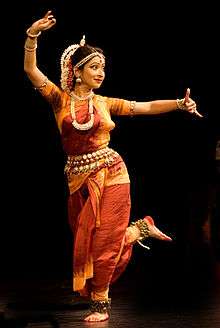
Asia
All Indian classical dances are to varying degrees rooted in the Natyashastra and therefore share common features: for example, the mudras (hand positions), some body positions, and the inclusion of dramatic or expressive acting or abhinaya. Indian classical music provides accompaniment and dancers of nearly all the styles wear bells around their ankles to counterpoint and complement the percussion.
There are now many regional varieties of Indian classical dance. Dances like "Odra Magadhi", which after decades long debate, has been traced to present day Mithila, Odisha region's dance form of Odissi (Orissi), indicate influence of dances in cultural interactions between different regions.[38]
The Punjab area overlapping India and Pakistan is the place of origin of Bhangra. It is widely known both as a style of music and a dance. It is mostly related to ancient harvest celebrations, love, patriotism or social issues. Its music is coordinated by a musical instrument called the 'Dhol'. Bhangra is not just music but a dance, a celebration of the harvest where people beat the dhol (drum), sing Boliyaan (lyrics) and dance. It developed further with the Vaisakhi festival of the Sikhs.
The dances of Sri Lanka include the devil dances (yakun natima), a carefully crafted ritual reaching far back into Sri Lanka's pre-Buddhist past that combines ancient "Ayurvedic" concepts of disease causation with psychological manipulation and combines many aspects including Sinhalese cosmology. Their influence can be seen on the classical dances of Sri Lanka.[39]
The dances of the Middle East are usually the traditional forms of circle dancing which are modernized to an extent. They would include dabke, tamzara, Assyrian folk dance, Kurdish dance, Armenian dance and Turkish dance, among others.[40][41] All these forms of dances would usually involve participants engaging each other by holding hands or arms (depending on the style of the dance). They would make rhythmic moves with their legs and shoulders as they curve around the dance floor. The head of the dance would generally hold a cane or handkerchief.[40][42]
Europe and North America
Ballet developed first in Italy and then in France from lavish court spectacles that combined music, drama, poetry, song, costumes and dance. Members of the court nobility took part as performers. During the reign of Louis XIV, himself a dancer, dance became more codified. Professional dancers began to take the place of court amateurs, and ballet masters were licensed by the French government. The first ballet dance academy was the Académie Royale de Danse (Royal Dance Academy), opened in Paris in 1661. Shortly thereafter, the first institutionalized ballet troupe, associated with the Academy, was formed; this troupe began as an all-male ensemble but by 1681 opened to include women as well.[5]
20th century concert dance brought an explosion of innovation in dance style characterized by an exploration of freer technique. Early pioneers of what became known as modern dance include Loie Fuller, Isadora Duncan, Mary Wigman and Ruth St. Denis. The relationship of music to dance serves as the basis for Eurhythmics, devised by Emile Jaques-Dalcroze, which was influential to the development of Modern dance and modern ballet through artists such as Marie Rambert. Eurythmy, developed by Rudolf Steiner and Marie Steiner-von Sivers, combines formal elements reminiscent of traditional dance with the new freer style, and introduced a complex new vocabulary to dance. In the 1920s, important founders of the new style such as Martha Graham and Doris Humphrey began their work. Since this time, a wide variety of dance styles have been developed; see Modern dance.
African American dance developed in everyday spaces, rather than in dance studios, schools or companies. Tap dance, disco, jazz dance, swing dance, hip hop dance, the lindy hop with its relationship to rock and roll music and rock and roll dance have had a global influence.
Latin America
Dance is central to Latin American social life and culture. Brazilian Samba, Argentinian tango, and Cuban salsa are internationally popular partner dances, and other national dances—merengue, cueca, plena, jarabe, joropo, marinera, cumbia, and others—are important components of their respective countries' cultures.[43] Traditional Carnival festivals incorporate these and other dances in enormous celebrations.[44]
Dance has played an important role in forging a collective identity among the many cultural and ethnic groups of Latin America.[45] Dance served to unite the many African, European, and indigenous peoples of the region.[43] Certain dance genres, such as capoeira, and body movements, especially the characteristic quebrada or pelvis swing, have been variously banned and celebrated throughout Latin American history.[45]
Dance education
Dance studies are offered through the arts and humanities programs of many higher education institutions. Some universities offer Bachelor of Arts and higher academic degrees in Dance. A dance study curriculum may encompass a diverse range of courses and topics, including dance practice and performance, choreography, ethnochoreology, kinesiology, dance notation, and dance therapy.

Occupations
Professional dancers are usually employed on contract or for particular performances or productions. The professional life of a dancer is generally one of constantly changing work situations, strong competitive pressure and low pay. Consequently, professional dancers often must supplement their incomes to achieve financial stability. In the U.S. many professional dancers belong to unions (such as the American Guild of Musical Artists, Screen Actors Guild and Actors' Equity Association) that establish working conditions and minimum salaries for their members. Professional dancers must possess large amounts of athleticism. To lead a successful career, it is advantageous to be versatile in many styles of dance, have a strong technical background and to utilize other forms of physical training to remain fit and healthy.[46]
Dance teachers typically focus on teaching dance performance, or coaching competitive dancers, or both. They typically have performance experience in the types of dance they teach or coach. For example, dancesport teachers and coaches are often tournament dancers or former dancesport performers. Dance teachers may be self-employed, or employed by dance schools or general education institutions with dance programs. Some work for university programs or other schools that are associated with professional classical dance (e.g., ballet) or modern dance companies. Others are employed by smaller, privately owned dance schools that offer dance training and performance coaching for various types of dance.
Choreographers are often university trained and are typically employed for particular projects or, more rarely may work on contract as the resident choreographer for a specific dance company.
Competitions

A dance competition is an organized event in which contestants perform dances before a judge or judges for awards, and in some cases, monetary prizes. There are several major types of dance competitions, distinguished primarily by the style or styles of dances performed. Major types of dance competitions include:
- Competitive dance, in which a variety of theater dance styles, such as acro, ballet, jazz, hip-hop, lyrical, and tap, are permitted.
- Open competitions, that permit a wide variety of dance styles. An example of this is the TV program So You Think You Can Dance.
- Dancesport, which is focused exclusively on ballroom and latin dance. Examples of this are TV programs Dancing with the Stars and Strictly Come Dancing.
- Single-style competitions, such as; highland dance, dance team, and Irish dance, that only permit a single dance style.
In addition, there are numerous dance competitions shows presented on television and other mass media.
Gallery
 Solo dance - Russian ballerina Marina Semjonova
Solo dance - Russian ballerina Marina Semjonova Folk dance - a trio of Irish Stepdancers performing in competition
Folk dance - a trio of Irish Stepdancers performing in competition A contemporary dancer performs a stag split leap
A contemporary dancer performs a stag split leap Dance partnering - a male dancer assists a female dancer in performing an arabesque, as part of a classical pas de deux
Dance partnering - a male dancer assists a female dancer in performing an arabesque, as part of a classical pas de deux Dance at Bougival by Pierre-Auguste Renoir (1882–83)
Dance at Bougival by Pierre-Auguste Renoir (1882–83) Acrobatic dance - an acro dancer performs a front aerial
Acrobatic dance - an acro dancer performs a front aerial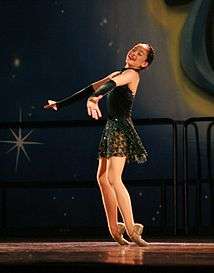 A dancer performs a "toe rise", in which she rises from a kneeling position to a standing position on the tops of her feet
A dancer performs a "toe rise", in which she rises from a kneeling position to a standing position on the tops of her feet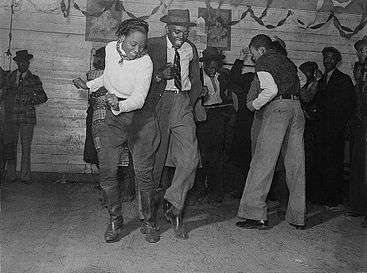 Social dance - dancers at a juke joint dance the Jitterbug, an early 20th century dance that would go on to influence swing, jive, and jazz dance
Social dance - dancers at a juke joint dance the Jitterbug, an early 20th century dance that would go on to influence swing, jive, and jazz dance- Latin Ballroom ballroom dancers perform the Tango
 Gumboot dance evolved from the stomping signals used as coded communication between labourers in South African mines
Gumboot dance evolved from the stomping signals used as coded communication between labourers in South African mines
 A hip-hop dancer demonstrates popping
A hip-hop dancer demonstrates popping Erotic dance - a pole dancer performs a routine
Erotic dance - a pole dancer performs a routine Prop dance - a fire dancer performance
Prop dance - a fire dancer performance Modern dance - a female dancer performs a leg split while balanced on the back of her partner
Modern dance - a female dancer performs a leg split while balanced on the back of her partner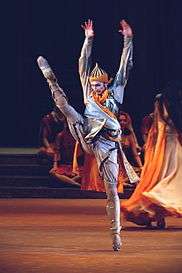 Stage dance - a professional dancer at the Bolshoi Theatre
Stage dance - a professional dancer at the Bolshoi Theatre.jpg) A nineteenth century artist's representation of a Flamenco dancer
A nineteenth century artist's representation of a Flamenco dancer Ritual dance - Armenian folk dancers celebrate a neo-pagan new year
Ritual dance - Armenian folk dancers celebrate a neo-pagan new year- A latin ballroom couple perform a Samba routine at a dancesport event
 Folk dance - some dance traditions travel with immigrant communities, as with this festival dance performed by a Polish community in Turkey
Folk dance - some dance traditions travel with immigrant communities, as with this festival dance performed by a Polish community in Turkey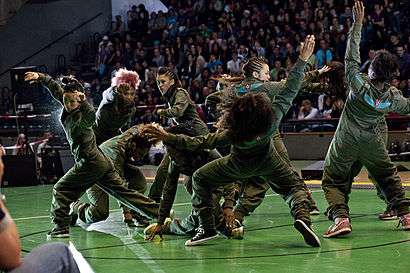 Street dancers at a competition
Street dancers at a competition A ballet dancer performs a standing side split
A ballet dancer performs a standing side split Street dance - a Breakdancer performs a handstand trick
Street dance - a Breakdancer performs a handstand trick
See also
| Performing arts |
|---|
Notes
- ↑ Many definitions of dance have been proposed. This definition is based on the following:
"Dance is human movement created and expressed for an aesthetic purpose."[1]
"Dance is a transient mode of expression performed in a given form and style by the human body moving in space. Dance occurs through purposefully selected and controlled rhythmic movements; the resulting phenomenon is recognized as dance both by the performer and the observing members of a given group."[2]
"Dance is human behaviour composed (from the dancer’s perspective, which is usually shared by the audience members of the dancer’s culture) of purposeful (individual choice and social learning play a role), intentionally rhythmical, and culturally patterned sequences of nonverbal body movement mostly other than those performed in ordinary motor activities. The motion (in time, space, and with effort) has an inherent and aesthetic value (the notion of appropriateness and competency as viewed by the dancer’s culture) and symbolic potential."[3]
References
- ↑ Sondra Horton Fraleigh (1987). Dance and the Lived Body: A Descriptive Aesthetics. University of Pittsburgh Pre. p. 49. ISBN 978-0-8229-7170-2.
- ↑ Joann Kealinohomoku (1970). Copeland, Roger; Cohen, Marshall, eds. An Anthropologist Looks at Ballet as a Form of Ethnic Dance (PDF). What is Dance? Readings in Theory and Criticism (1983 ed.). New York: Oxford University Press.
- ↑ Judith Lynne Hanna (1983). The performer-audience connection: emotion to metaphor in dance and society. University of Texas Press. ISBN 978-0-292-76478-1.
- ↑ Canadian National Arts Centre - Dance Forms: An Introduction
- 1 2 Nathalie Comte. "Europe, 1450 to 1789: Encyclopedia of the Early Modern World". Ed. Jonathan Dewald. Vol. 2. New York: Charles Scribner's Sons, 2004. pp 94–108.
- ↑ Guenther, Mathias Georg. 'The San Trance Dance: Ritual and Revitalization Among the Farm Bushmen of the Ghanzi District, Republic of Botswana.' Journal, South West Africa Scientific Society, v30, 1975–76.
- ↑ Raftis, Alkis, The World of Greek Dance Finedawn, Athens (1987) p25.
- ↑ Yemenite Dances and their influence on the new Jewish folk dances
- ↑ "Basin with design of dancers". National Museum of China. Pottery from the Majiayao culture ( 3100 BC to 2700 BC)
- ↑ Wang Kefen (1985). The History of Chinese Dance. China Books & Periodicals. p. 7. ISBN 978-0835111867.
- ↑ Zehou Li (2009). The Chinese Aesthetic Tradition. translated by Maija Bell Samei. University of Hawaii Press. p. 5. ISBN 978-0824833077.
- ↑ Lü Shi Chun Qiu Original text: 昔葛天氏之樂,三人操牛尾,投足以歌八闋
- 1 2 Shawn, Ted, Dance We Must, 1946, Dennis Dobson Ltd., London, p.50
- ↑ Imperial Society of Teachers of Dancing, Ballroom Dancing, Teach Yourself Books, Hodder and Stoughton, 1977, p. 38
- 1 2 3 Lincoln Kirstein, Dance, Dance Horizons Incorporated, New York, 1969, p.4
- ↑ Shawn, Ted, Dance We Must, 1946, Dennis Dobson Ltd., London, p.49
- ↑ Lincoln Kirstein, Dance, Dance Horizons Incorporated, New York, 1969, p.3
- ↑ Matthew 11:17
- ↑ Lincoln Kirstein, Dance, Dance Horizons Incorporated, New York, 1969, p.108
- ↑ Lincoln Kirstein, Dance, Dance Horizons Incorporated, New York, 1969, p.157
- ↑ Scholes, Percy A. (1977). "Dance". The Oxford Companion to Music (10 ed.). Oxford University Press.
- ↑ Émile Jaques-Dalcroze, Rhythm, Music and Education, 1973, The Dalcroze Society, London, p.viii
- ↑ Émile Jaques-Dalcroze, Rhythm, Music and Education, 1973, The Dalcroze Society, London, p.181
- ↑ Shawn, Ted, Dance We Must, 1946, Dennis Dobson Ltd., London, p.54
- ↑ Shawn, Ted, Dance We Must, 1946, Dennis Dobson Ltd., London, p.50-51
- ↑ Moller, Helen and Dunham, Curtis, Dancing with Helen Moller, 1918, John Lane (New York and London), p.74)
- ↑ Laban, Rudolf, The Mastery of Movement, MacDonald and Evans, London, 1960, p. 2
- ↑ Minden, Eliza Gaynor, The Ballet Companion: A Dancer's Guide, Simon and Schuster, 2007, p.92
- ↑ Thoinot Arbeau, Orchesography, trans. by Mary Stewart Evans, with notes by Julia Sutton, New York: Dover, 1967
- ↑ Laban, Rudolf, The Mastery of Movement, MacDonald and Evans, London, 1960, pp. 2,4 et passim
- ↑ Laban, Rudolf, The Mastery of Movement, MacDonald and Evans, London, 1960, p. 86
- ↑ Abigail Wagner, A Different Type of Rhythm, Lawrence University, Wisconsin
- ↑ "Kabuki « MIT Global Shakespeares". Retrieved April 8, 2015.
- ↑ Ortolani, Benito (1995). The Japanese theatre: from shamanistic ritual to contemporary pluralism. Princeton University Press. p. 132. ISBN 0-691-04333-7.
- ↑ Ayansu, E. S. and Whitfield, P. (eds.), The Rhythms Of Life, Marshall Editions, 1982, p. 161
- 1 2 Kariamu Welsh; Elizabeth A. Hanley; Jacques D'Amboise (1 January 2010). African Dance. Infobase Publishing. ISBN 978-1-60413-477-3.
- 1 2 3 Hanna, Judith Lynne (1973). "African Dance: the continuity of change". Yearbook of the International Folk Music Council. 5: 165–174. JSTOR 767501.
- ↑ Exoticindiaart.com, Dance: The Living Spirit of Indian Arts, by Prof. P. C. Jain and Dr. Daljeet.
- ↑ Lankalibrary.com, "The yakun natima — devil dance ritual of Sri Lanka"
- 1 2 Badley, Bill and Zein al Jundi. "Europe Meets Asia". 2000. In Broughton, Simon and Ellingham, Mark with McConnachie, James and Duane, Orla (Ed.), World Music, Vol. 1: Africa, Europe and the Middle East, pp 391-395. Rough Guides Ltd, Penguin Books.
- ↑ Recep Albayrak Hacaloğlu. Azeri Türkçesi dil kilavuzu. Hacaloğlu, 1992; p. 272.
- ↑ Subhi Anwar Rashid, Mesopotamien, Abb 137
- 1 2 John Charles Chasteen (1 January 2004). National Rhythms, African Roots: The Deep History of Latin American Popular Dance. UNM Press. pp. 8–14. ISBN 978-0-8263-2941-7.
- ↑ Margaret Musmon; Elizabeth A. Hanley; Jacques D'Amboise (2010). Latin and Caribbean Dance. Infobase Publishing. pp. 20–23. ISBN 978-1-60413-481-0.
- 1 2 Celeste Fraser Delgado; José Esteban Muñoz (1997). Everynight Life: Culture and Dance in Latin/o America. Duke University Press. pp. 9–41. ISBN 0-8223-1919-5.
- ↑ Sagolla, Lisa (April 24, 2008). "Untitled". International Bibliography of Theatre & Dance with Full Text. 15 (17): 1.
Further reading
- Abra, Allison. "Going to the palais: a social and cultural history of dancing and dance halls in Britain, 1918–1960." Contemporary British History (Sep 2016) 30#3 pp 432–433.
- Blogg, Martin. Dance and the Christian Faith: A Form of Knowing, The Lutterworth Press (2011), ISBN 9780718892494
- Carter, A. (1998) The Routledge Dance Studies Reader. Routledge. ISBN 0-415-16447-8.
- Cohen, S, J. (1992) Dance As a Theatre Art: Source Readings in Dance History from 1581 to the Present. Princeton Book Co. ISBN 0-87127-173-7.
- Daly, A. (2002) Critical Gestures: Writings on Dance and Culture. Wesleyan University Press. ISBN 0-8195-6566-0.
- Miller, James, L. (1986) Measures of Wisdom: The Cosmic Dance in Classical and Christian Antiquity, University of Toronto Press. ISBN 0-8020-2553-6.
External links
 Chisholm, Hugh, ed. (1911). "Dance". Encyclopædia Britannica (11th ed.). Cambridge University Press.
Chisholm, Hugh, ed. (1911). "Dance". Encyclopædia Britannica (11th ed.). Cambridge University Press.- Historic illustrations of dancing from 3300 B.C. to 1911 A.D. from Project Gutenberg
- United States National Museum of Dance and Hall of Fame